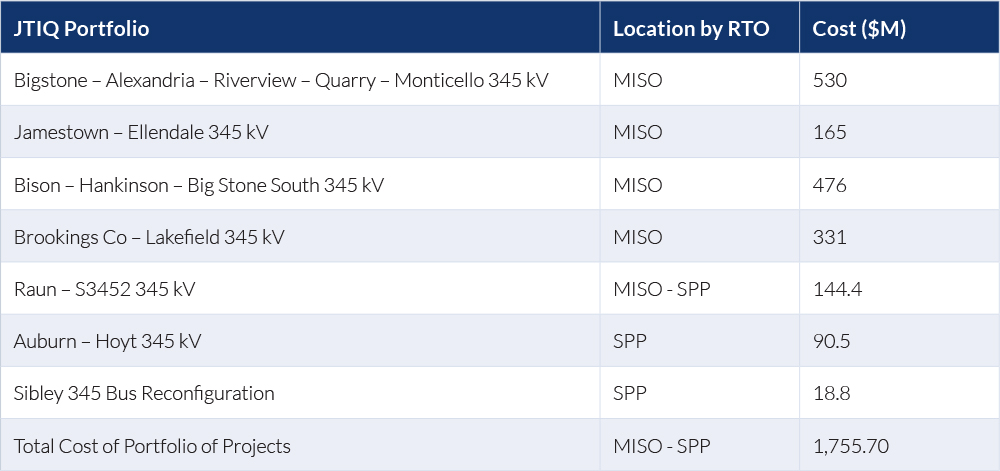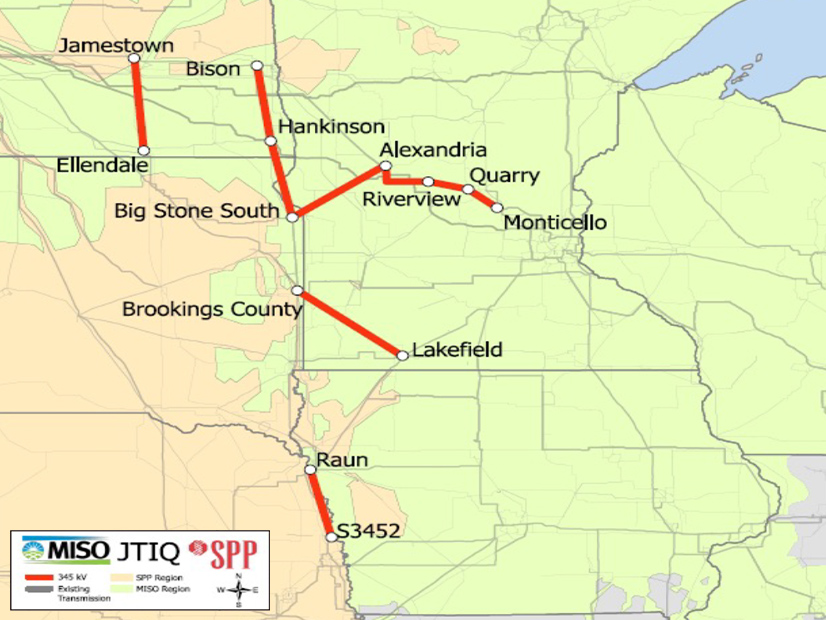MISO and SPP staff on Friday gave stakeholders their first chance to discuss and comment on the Joint Targeted Interconnection Queue (JTIQ) study, the culmination of a rare collaboration by the RTOs that began in 2020.
Staff said during a joint stakeholder meeting that the study resulted in seven projects that would cost an estimated $1.755 billion and “fully resolve” its targeted transmission constraints. The projects, six 345-kV transmission lines and a 345-kV bus reconfiguration, would deliver $724 million and $247 million of adjusted production cost (APC) benefit to customers in the MISO and SPP footprints, respectively, with a cumulative benefit-to-cost ratio of 0.56.
Four of the transmission projects are in MISO’s footprint in the Dakotas and Minnesota; one is in SPP’s; and the last crosses the seam. The bus reconfiguration is in SPP’s region.
David Kelley, SPP’s director of seams and tariff services, said he was unsure whether other grid operators had undertaken a similar collaborative effort to produce what he called “pretty exciting” information. (See MISO, SPP to Conduct Targeted Transmission Study.)
“I wanted to just mention briefly how cool, honestly, it has been to be part of such a novel study that has never been conducted before, at least between SPP and MISO,” he said. “You guys get to see the work as it’s taking place … but you all really miss, I think, the interaction that takes place on a week-to-week basis between what has been a really good team of engineers, analysts and a number of other supporting cast members that have … worked so closely together to bring to you the product that we’re very happy to share with you today.”
SPP’s power-flow models found the projects could enable as much as 53 GW of generating capacity for new interconnection projects on the seam. MISO’s models came up with 28 GW of new capacity.
Asked why the RTOs’ models were off, Kelley said their planning processes are “fundamentally different.”
“We even started with somewhat of a different future in the production cost modeling,” he said. “Even when you call the futures the same thing, different assumptions go into them. It’s more indicative and should be viewed as qualitative.”
David Johnson, an Indiana Utility Regulatory Commission staffer, asked to see the numbers in dollars per megawatt to interconnect to the system “because it says it’s an interconnection study.”
“Tell me what the [bogey] would be if all of these projects that are connected individually along the way and those interconnection costs,” he said. “All these studies make tons of assumptions.”
Staff agreed with Johnson that it would be a “monumental task.” MISO’s Andy Witmeier, director of resource utilization, said the capacity enabled calculations included generation enabled by JTIQ-mitigated constraints and additional generation by using unused capacity on mitigated constraints and the study’s projects.
Witmeier said a supplemental study conducted by an SPP consultant found that, consistent with the JTIQ analysis, 60% of the constraints assigned to MISO interconnection customers for mitigation could be addressed by the joint portfolio. The consultant’s work also indicated the portfolio alleviated the need to mitigate 44% of the constraints — representing more than $301 million of the assigned network upgrade costs — in an SPP study cluster.
 The draft JITQ portfolio of projects | MISO, SPP
The draft JITQ portfolio of projects | MISO, SPP
Cost allocation conversations are ongoing and additional stakeholder meetings will be scheduled in the first quarter, staff said.
“I believe it’s important to continue cost allocation discussions, but under the banner of the JTIQ,” Witmeier said. “We want to come up with cost allocations to hopefully get these projects built.”
Staff have already run modifications revising the joint operating agreement’s queue priority through the stakeholder process in both RTOs. A joint filing at FERC is expected in the next couple of weeks.
Stakeholders have until Thursday to provide feedback on the JTIQ study; a final report is expected Feb. 10.
The JTIQ study began as a mechanism to identify transmission projects required to address the significant transmission limitations restricting the interconnection of new generation near the SPP-MISO seam. Recognizing that large-scale transmission often provides multiple benefits, the study’s “novel” approach meant simultaneously considering whether transmission necessary to unlock the RTOs’ bulging generation interconnection queues could also provide economic and reliability benefits to their transmission customers.
The team closely coordinated the grid operators’ technical analyses, using each RTO’s respective transmission and generation planning methodologies to determine the project requirements that would cost-effectively resolve the transmission constraints inhibiting new generation near their seam. Staff performed reliability, economic and transfer capability studies and coordinated with stakeholders to develop solutions that met the study’s objectives.



